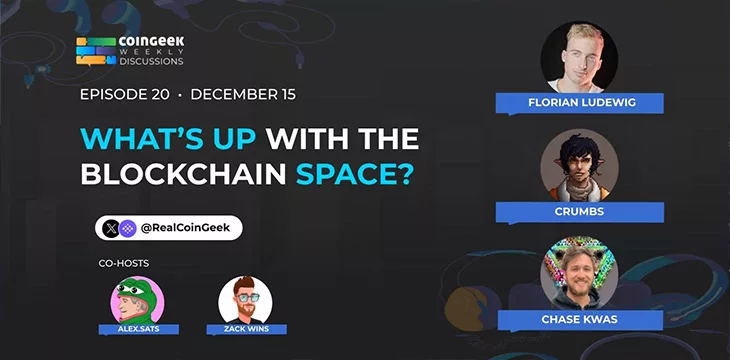|
Getting your Trinity Audio player ready...
|
In this episode of CoinGeek Discussion, co-hosts Zachary Weiner and Alex Vidal talked to guests Florian Ludewig, Crumbs, and Chase Kwas about the most important news in the blockchain space, their Bitcoin stories, and whether Bitcoin can ultimately replace the internet. Check it out via this link.
Introducing the guests speakers
On this week’s episode, three guests joined to share their thoughts. They were:
Florian Ludwig – aka Flo, is a developer and blockchain enthusiast.
Crumbs – a developer who works at Fortune 500 companies. He says, “Bitcoin is a store of valium.”
Chase Kwas – a Bitcoin enthusiast with an interest in philosophical questions such as “What is money?“
Of course, the discussion was led by Vidal and Weiner, both of whom worked hard to make this discussion happen on a weekly basis.
The most important news in blockchain this week
Weiner highlights a huge news story: Lloyds did a fully auditable, compliant transaction with partner bank Santander. This crossed yet another line to the realization that Bitcoin is a better payment method.
In other important news, BSV blockchain put another 20 million Ordinals on the blockchain. Weiner says the “rocket boosters are starting to fire” as the BSV blockchain picks up steam.
Does BCH have Ordinals? Weiner says no, but they have something native to that chain. If there were anything to compare, it would be right in the middle between BTC and BSV.
Weiner is a fan of the new and novel ways to interact with BSV-20s, NFTs, and more. While tokens like HODL and Bamboo are fun, the things that can be built around them are more interesting. All this activity has led to transaction volumes that would have killed many other blockchains, but BSV blockchain is handling them without any issues.
According to Ludewig, the biggest news is Lock-to-Mint and what’s going on with it. He recently discovered this and was immediately interested in it.
Crumbs agrees with Flo, adding that all the drama inscriptions on BTC are fun to watch. For those who don’t know, some BTC maximalists threaten to nix inscriptions and treat them as an attack on Bitcoin.
The speaker’s Bitcoin stories
Vidal always asks the guests how they found out about Bitcoin. Here are the stories for each of the guests.
Flo first heard about Bitcoin in 2017 but lost interest after the hype died down. He got interested again in 2021 from a privacy perspective. These days, he’s hooked on it and loves watching the BSV blockchain ecosystem evolve. He’s working on various applications and says putting 3D models onto the blockchain is already possible.
Crumbs discovered Bitcoin while working at a large corporation. He worked on things that made him rethink values, such as privacy. Wanting to get out of the rat race, he started reading about economics, which led to Bitcoin. He quickly realized Ethereum couldn’t scale, and it was possible to do smart contracts on Bitcoin. He credits Daniel Krawisz with teaching him a lot.
Kwas got into Bitcoin in 2017. He had questions about money and didn’t want to use fiat. After exploring Bitcoin, he wondered why so many other coins exist. On top of this, he tried to find out who Satoshi Nakamoto was. After the Bitcoin network split, he learned that the BSV blockchain can do microtransactions, and he believes the one that can do the most of them will win.
On the potential groundbreaking use cases for blockchain, Ludewig says it can replace the internet in its entirety, and Crumbs sees value in accountability for both the government and large companies. Kwas says micropayments can revolutionize how the internet works, moving us away from the ad-based model.
Creating on Bitcoin
Vidal asks Ludewig about the first thing he created on Bitcoin. He says he watched videos by sCrypt and realized it’s possible to build apps on Bitcoin. A friend who was familiar with putting stuff on the blockchain introduced him. He then built an indexer and web page for the token OG, checking the first 10,000 blocks, and created a tool to mint special numbers such as 7777.
Weiner asks Crumbs what advice he has for people designing on the BSV blockchain. He advises us to try stuff and don’t be too dogmatic in our approach. BSV blockchain is too insular, he says, and we need to look at some of the great apps being built on other blockchains, too.
Chase is more interested in Bitcoin from a philosophical perspective. He says his studies have shown him that we started with credit systems, then moved on to gold, and then plastics. He rightly says that most people never think about money and why things like taxes exist. He wrote a book and published it on Canonic, generating some sales. He says it’s a great way to establish yourself outside the Amazon ecosystem (NASDAQ: AMZN).
What does Flo see himself building next? He’s not sure yet, but perhaps it will be related to tooling for building websites on the BSV blockchain.
What do the speakers think is required for the mass adoption of Bitcoin? Flo reiterates that it has to be used as plumbing in the background. Crumbs seconds that, saying regular people just want to use and benefit from apps. They don’t want to have to think about technology.
To hear more about how everything will run on Bitcoin and what the speakers are working on, check out the discussion here.
Watch: CoinGeek Weekly Livestream with Kurt Wuckert Jr. – AMA and Clip Show

 07-18-2025
07-18-2025 





